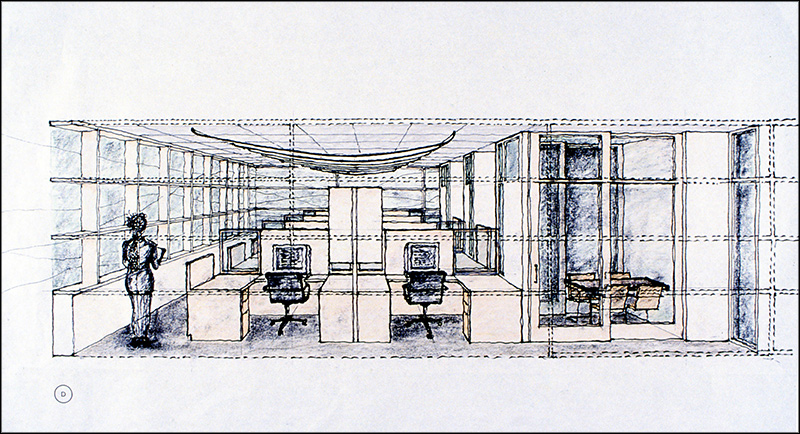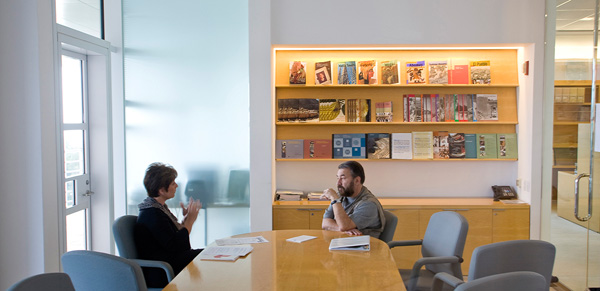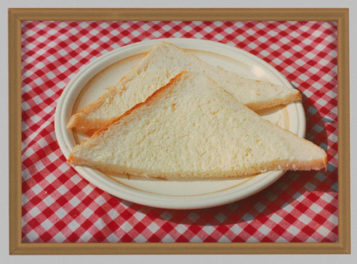
The original Getty Conservation Institute headquarters in Marina del Rey. Photo: Dingeman Kalis
In summer 1996, the Getty Conservation Institute was poised to move from its first headquarters in Marina del Rey, near the Pacific Ocean, to its current location at the Getty Center. It was a unique moment in the life of the Institute—not only would it mark an address change, but it would come to influence how we collaborated with colleagues.
Our original headquarters, which we moved into in summer 1985, was a lone building in a rental office park in the middle of a quiet suburban neighborhood. We shared the office park with a shoe company, a frequent-flyer program, and a 35mm film development company.
By contrast, our move to the Getty Center would put us on a 710-acre hillside campus with our sister programs, the Getty Museum, Research Institute, and Foundation. By 1998, when the Getty Center opened to the public, we would also be sharing the site with tens of thousands of visitors and tourists a year.

Senior staff and members of the transition team visit the Conservation Institute during construction.
As a member of the team tasked with helping the Conservation Institute relocate to the Getty Center, I served as a liaison between our science department staff and the Center’s architects and Getty building program staff. Among the many changes accompanying our move, two of the most significant were our purpose-built laboratories and our open office environment.
The Right Plug in the Right Place
With our move to the Getty Center, our science staff would have laboratories designed specifically for their research. Planning for these laboratory spaces began years in advance with scientists working closely with the Getty Center’s architect, Richard Meier & Partners, as well as the Getty’s building program department on countless matters, from isolating vibration and noise of the chiller pumps for the environmental scanning electron microscope, to equipping the X-ray equipment rooms with the required lead-lining, to creating adequate storage spaces.

View of one of the Conservation Institute laboratories. Photo: Scott Warren
The contents of the labs began their move a month in advance of GCI staff. Specialized handlers were required to move materials from the chemical stockrooms and reference collection, while specialists handled, installed, and calibrated sensitive analytical equipment.
Thanks to our months of careful planning, we knew exactly which piece of equipment would go onto which countertop in a particular lab, and even which outlet it would plug into. But amid this careful consideration, scientists and architects were equally mindful that the layout needed to be somewhat flexible. Thanks to this foresight, our labs have proved to be adaptable as our scientific research has evolved and expanded.
No Offices?
One aspect of our new headquarters that raised a few eyebrows was the architect’s proposal for an open-concept floorplan—no offices for staff, and workstations roughly equal in dimensions.

Architectural sketch showing our open-office floor plan.
The open-office concept was relatively new to many of us. In order to help us envision how the new workspace would take shape, the relocation team visited local offices, including the West Coast headquarters for Chiat/Day and Toyota’s national headquarters, where open office space was used on a large scale.
While this concept might seem to result in nothing more than a sea of boring cubicles, our workstations were designed with one wall tall enough to provide privacy, bookshelves for storage, and, in many cases, glass panels to allow natural light to filter through the office.

Some of our offices as they look today.
The open plan facilitated collaboration within and among our multidisciplinary project teams. It also made the most of the building’s vast windows and sweeping views of Los Angeles. On clear days staff can enjoy views of the Pacific Ocean and Channel Islands, the Griffith Observatory, and the downtown skyline.
What About Meetings?
To accommodate the need for meetings and privacy, the architects designed approximately 20 meeting rooms scattered over four floors of the East Building. The rooms range in size from rooms for two people to one that holds as many as 100.
To help staff remember where these are located, the rooms were named after sites inscribed on the UNESCO’s World Heritage List. Among the sites represented are Great Zimbabwe, Angkor Wat, Uluru, Sans Souci, and Herculaneum.

One of our larger meeting rooms, the Angkor Wat conference room. Photo: Dennis Keeley
Together at Last
Every day I’m reminded of another important aspect of our move—we share a campus with colleagues from our sister programs. Being together at the Getty Center has meant we can easily walk across the plaza to meet with colleagues or get casual updates on work while passing in the halls or eating lunch at the Cafe. It has enhanced our daily working relationships, promoted collaboration, and encouraged the exchange of ideas across programs.




Such a wonderful journey!!!